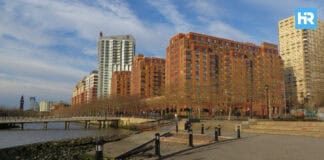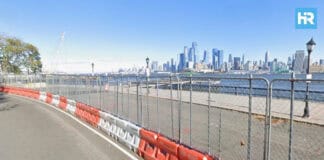On June 2, 2025, Hudson County officials installed a section of the Berlin Wall in Laurel Hill Park, Secaucus, New Jersey. The wall segment was gifted in 2007 by Oberhavel County in Brandenburg, Germany, Hudson County’s sister county since 2000.
The wall segment is made of steel-reinforced concrete. It weighs 26,156 pounds and stands 11 feet 9 inches tall. Consisting of four parts, each 3 feet 10 inches wide, it is secured together by a masonry tube coping. The section lacks graffiti but shows bullet holes and weather damage. It is believed to have been on the eastern side of the wall, where graffiti was prohibited.
The wall is now located at the top of the amphitheater in Laurel Hill Park, across from the playground.
- A 26,156-pound section of the Berlin Wall was installed on June 2, 2025, in Laurel Hill Park, Secaucus, after being gifted by Oberhavel County, Germany in 2007.
- The wall piece came from the French-controlled area of West Berlin and shows bullet holes and weather damage, with no graffiti.
- The site includes a Cold War mural, a QR-coded plaque, and serves as a permanent public exhibit on Cold War history.
Origin and Historical Background
The Berlin Wall divided East and West Berlin from 1961 to 1989. The Soviet Union constructed it to stop the flow of East Germans to the West. The wall was built during the leadership of Soviet Premier Nikita Khrushchev. It fell in November 1989 under Soviet Premier Mikhail Gorbachev. The Soviet Union dissolved in 1991.
The wall segment now in Secaucus came from West Berlin, in a sector controlled by the French Army after World War II. Former German State Minister Karl-Heinz Schröter and former Hudson County Cultural Affairs Director Bill LaRosa assisted in arranging the donation. According to LaRosa, this section was part of what was called a “death wall,” where East German guards were ordered to shoot people trying to escape.
Delays and Installation
Although the wall was received in 2007, it took over 15 years to be installed. County officials spent years identifying a location that offered adequate protection from weather and allowed for public access and security. Laurel Hill Park was selected based on visibility, available space, and infrastructure.
The wall had begun to deteriorate before installation. According to Kevin Wong, Deputy Director of Hudson County Parks, the wall had exposed rebar and needed restoration. Repairs included patching and reinforcing the structure. A security camera has been installed, and another is planned. Officials are also considering applying an anti-graffiti coating.
Ceremony and Educational Features
The June 2 ceremony included several Hudson County officials. County Executive Craig Guy led the event. “During the Cold War, the wall was used to block the right of passage from thousands of families,” Guy said. “Today it stands as a reminder of the value of unity and freedom for generations to come.”
Commissioner Yraida Aponte-Lipski called the unveiling “a touching moment” and stated the wall is a “symbol of unity that is badly needed.”
Paul Silverman, co-founder of Silverman Real Estate, traveled to Germany to assist with the project. His company restores historic structures. “Having it here symbolizes friends and relationships,” he said.
The wall installation is supported by a mural and a memorial plaque. The mural features U.S. President John F. Kennedy, Soviet Premier Nikita Khrushchev, and musician Bruce Springsteen. Springsteen played a concert in East Berlin in 1988, one year before the wall fell.
The plaque explains the Berlin Wall’s history from 1961 to 1989 and includes a QR code linking to additional information. The Hudson County Office of Cultural & Heritage Affairs described the installation as a “living classroom.” Director Gina Hulings said it helps children and adults “learn and remember the significance of the fall of the Berlin Wall—a symbol of triumph for freedom and democracy worldwide.”






